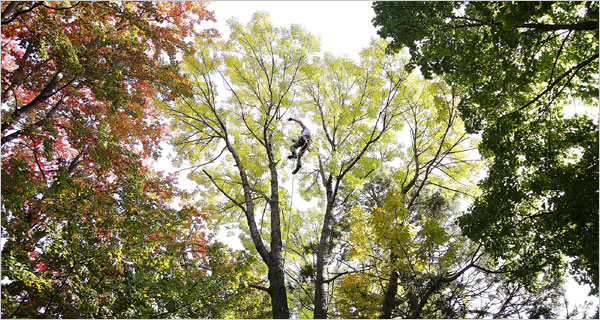Although the Boston Globe, which is owned by the New York Times, often publishes international and national stories from it’s parent paper, the Times apparently chose not to return the favor in assigning its own reporter (or, perhaps, freelancer) Ariana Green to follow up on an article about the Asian beetle infestation in Worcester, Mass., a city in the Globe’s own backyard. The Times has written other stories on the problem, mostly about the greater New York metropolitan and New Jersey areas, while the Worcester Telegram and Gazette — also owned by the Times — has provided even more extensive coverage
 The Times story, “Asian Beetle Spells Death for Maples So Dear: An Infestation in Massachusetts,” appeared in its November 28 New England edition; Carolyn Y. Johnson’s Globe article, “Swat Team Takes to Trees: Battling the Beetle Threatening N.E.’s Forests,” appeared October 18 on Page One, beating the Times by more than six weeks.
The Times story, “Asian Beetle Spells Death for Maples So Dear: An Infestation in Massachusetts,” appeared in its November 28 New England edition; Carolyn Y. Johnson’s Globe article, “Swat Team Takes to Trees: Battling the Beetle Threatening N.E.’s Forests,” appeared October 18 on Page One, beating the Times by more than six weeks.
Perhaps the Times story was inspired by the Globe, or perhaps the scale of the Worcester effort caught the eye of a Times editor, but whatever the motive, Green appears to have followed the ethical adage of journalists to “do your own reporting.” In her report, she develops a fresh angle on the story: Worcester’s decision following a 1953 tornado to replace most of its downed trees with Norway maples contributed to its current problems. Nowadays, foresters recommend that communities diversify their tree populations to avoid widespread devastation of the kind Worcester now faces. Here’s how Green moves the story from her lead to the larger issue she wants to explain:
WORCESTER, Mass. — People who live in this city’s Greendale neighborhood love the maples that shade their streets in summer and turn beautiful colors in fall. But most of the maples in Greendale are now painted with red dots, indicating that they will be chopped down as early as next month because of an infestation of Asian long-horned beetles that is plaguing thousands of Worcester’s trees.
When a tornado devastated Worcester in 1953, maples were planted as replacement trees. “Norway maples were readily available back then,” said Brian Breveleri, the city’s urban forester. “And they were popular because they could weather the cold.”
But when Worcester plants new trees this time around, it will vary the type. A tree inventory, completed in 2006, showed that 80 percent of its street trees were maples, which the beetles find irresistible. The city should ideally have about half as many maples.
These three paragraphs set up Green’s article for her reporting on diversification as a preventative strategy, the need for communities to complete tree inventories in order to implement such a strategy, and the availability of new software that makes it possible for volunteers to help professionals identify infested trees.
Green quotes eight sources, six experts from the region and two residents of the Greendale neighborhood in Worcester; Johnson quotes four experts, all from Massachusetts, and one resident. The articles are roughly equal in length. There is no overlap in content. Green’s report seems, at times, more deeply reported, revealing, for example, that a professional inventory team failed to spot the beetle in Worcester in 2006, and that the pest was first detected by Greendale residents this summer. But Johnson is alone in explaining how the beetle actually does its damage and why the Worcester infestation is unique (it’s the first large infestation discovered so close to a forested area , the woods of New England). She’s also the only one to explain what must be done with an infested tree once the beetle is detected, as well as the emotional impact of cutting it down on homeowners and neighborhood residents.
The Times article ends by returning to Worcester, noting that the beetle was first spotted by residents and complaints the city was too slow to respond. But it ends on a hopeful note, with words from the resident of the Greendale neighborhood who spotted the first beetle.
In Worcester, Donna Massie, a resident of Greendale, first noticed the beetle this summer and reported it to the authorities. Ms. Massie is eager to help with eradication efforts, but other residents are angry that the beetle went undetected for so long.
“It seems to me that Worcester just drags its feet,” said Donald Huard, 58, a handyman who lives on an affected street. “And now look; the problem is so big it’s really going to change our landscape.”
Ms. Massie, 53, is trying to get her neighbors to stay positive and informed through her Web site, asianlonghornedbeetleitems.com, which also sells beetle-themed goods like lacquered frozen beetles in wooden boxes and beetle Christmas ornaments. She plans to give half her proceeds to the city for replanting.
“Some people blame the government for catching the problem after the beetles already had time to spread,” she said. “But, really, it’s the beetle’s fault, and we’re all responsible, so the best thing to do now is to get educated and deal with the situation before it gets even bigger.”
